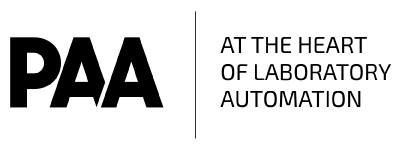Mitsubishi Electric has supported Peak Analysis & Automation (PAA) in the delivery of an innovative, fully automated laboratory workcell for bacteriological studies to the U.S. Department of Commerce’s National Institute of Standards and Technology (NIST).
The application is built around a Mitsubishi Electric MELFA articulated arm robot with its own proximity-based safety solution. Scientists at NIST can now benefit from a flexible and reliable system to perform several bacterial growth tests in parallel, significantly shortening discovery times and reducing the risk of contamination.
NIST is a science and technology laboratory whose research efforts include developing and promoting common guidelines, practices and standards for industry, public bodies and academia. Its purpose is to drive U.S. innovation and competitiveness.
The automated laboratory from Mitsubishi Electric and PAA provides specific environmental conditions for the proliferation of studied organisms whilst also avoiding sample contamination.
Automated solutions act as a breeding ground for innovation
As a global leader in laboratory automation for life sciences, PAA offers a cutting-edge solution that supports optimal testing and measurement. The company provided one of their flexible solutions, the S-CEL™ Robotic System, which is a fully integrated, modular and customisable workcell that can accommodate a broad range of devices to meet different research requirements.
By using automated process technology, scientists can avoid tedious and repetitive tasks and concentrate on analysing laboratory data. For this specific application, NIST and PAA planned a system that would automatically prepare culture media for bacteria, manipulate the organisms’ DNA and measure their growth rates as well as any underlying patterns.
The workcell features a laminar clean air system that flushes away airborne contaminants and protects the biological samples and equipment within the unit from contamination. Once inside, the S-CEL™ system is comprised of devices to store the microtiter plates, where the microbes are cultivated, as well as plate readers and incubators to monitor bacterial growth in set conditions.
In order to modify the organisms, the unit also enables a nuclear vector transfer function for genetic material. Other key components include liquid handlers for pouring growth media substrates into the plates, plate sealers and peelers that cover or remove seals and lids from the microtiter plates, as well as temperature-controlled centrifuges to spin samples when required.
All these instruments, located around the workcell, required an automated pick and place solution, to move samples and consumables around the different stations to perform all the relevant tasks without any human intervention. Furthermore, a high-throughput system which can perform a number of tests simultaneously would help scientists obtain key results in a fraction of the time required using manual methods. The optimal solution was provided by Mitsubishi Electric, PAA’s preferred industrial automation specialist.
Andy Mash, Integration Manager at PAA, comments: “We have a longstanding and successful relationship with Mitsubishi Electric, which is our go-to brand when it comes to automation products. Technically speaking, their high-quality solutions are easy to integrate, accurate and reliable.”
Moving around inside the cell
The solution provided by Mitsubishi Electric is its MELFA RV series six-axis articulated robotic arm and controller. The robot is mounted onto a linear slide that allows movement around the microbiology unit to move materials from one station to another.
Neal Welch, Life Science Sales Manager at Mitsubishi Electric, explains: “A key feature of our solution is its intrinsic adaptability. This is how we were able to adapt the robotic motion within the workcell as well as interface the MELFA RV-2FL six-axis robot with existing softwares from NIST and PAA.”
Another key issue solved by this flexible automation solution was the positioning of items within the workcell. For example, the liquid handler uses disposable tips, whose coordinates can slightly vary every time. By being able to assess its location, the machine can compensate for small variations in positioning and recalculate its own position relative to the consumables. As a result, accuracy in operation is maintained.
In addition, as the microbiology unit uses liquids and powdered materials, Mitsubishi Electric’s robot was designed to feature IP67 ingress protection rating against dust and water.
Automation with room for human intervention
The new cell can also send alerts or notifications when necessary. One example would be when consumables are about to finish, so they can be replenished in time, avoiding any unplanned downtime.
While the cell can operate independently most of the time, restocking supplies constitutes an instance when a person needs to access the workcell. When scientists or operators want to enter the S-CEL™ Robotic system, ensuring safe operations is of utmost importance. Mitsubishi Electric robot again provides an ideal solution.
Neal Welch explains: “To maximise the capabilities of the system, we delivered a robot solution that keeps on performing its tasks even when scientists or operators enter the workcell. The robot will simply move away from operators and continue working at different work stations, avoiding the locations where humans are present. In this way, downtime is minimised even further.”
Integrated systems enable fast scientific breakthroughs
As a result, the multifunctional solution developed by Mitsubishi Electric and PAA will help NIST scientists reduce the risk of contamination in their experiments as well as produce sound standards and measurements far more quickly than with traditional, manual operations. This, in turn, leads to quicker discoveries and innovations from the industries, universities and public bodies supported by work at NIST.
Andy Mash comments: “We take pride in providing high-quality products that ensure customer satisfaction and profitability. NIST is a prestigious organisation and the positive feedback we have received provides confirmation that our efforts have been well received. Thanks to the collaboration with Mitsubishi Electric, we were able to deliver an innovative solution using the latest automation technologies.”
Neal Welch concluded: “We are proud of having been part of this cutting-edge project. In particular, we are excited to see its capabilities in promoting advanced research and innovation in microbiology. These could lead to key discoveries in fields such as human health and precision medicine.”


